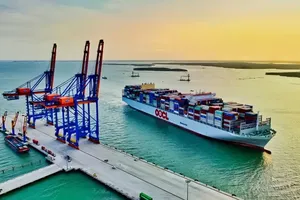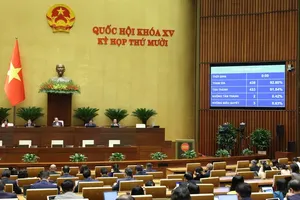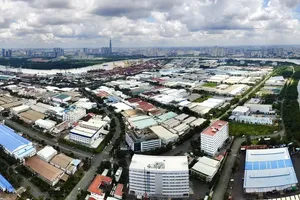That was heard at the CEO Forum 2025 under the theme: “Strategies for Market Expansion Amid the Trade War.” Sai Gon Giai Phong Newspaper, in collaboration with the Ho Chi Minh City Institute for Development Studies (HIDS) and the Ho Chi Minh City Union of Business Association (HUBA), hosted the forum on the morning of May 21.
Dr. Can Van Luc, Member of the Prime Minister’s Economic Advisory Council: Entrepreneurs are ‘warriors’ on the economic frontline
Vietnamese businesses are currently facing mounting challenges both domestically and internationally, requiring concerted efforts from the central government, local authorities, and party leadership alike.

Addressing the trade tensions, Dr. Can Van Luc outlined three potential scenarios. The optimistic one—though only 20 percent likely—would see businesses dealing with a 10–15 percent tariff on exports to the US, a rate similar to that faced by exporters in 126 other countries. A pessimistic scenario, also with a 20 percent probability, would involve a 46 percent tariff. The most probable outcome, with a 60 percent chance, is a baseline scenario in which Vietnamese exports incur tariffs of 20–25 percent.
Reflecting on recent developments, Dr. Can Van Luc noted that from 2019 to 2024, Vietnam saw an average of 143,500 new businesses registered annually—1.3 times higher than in the 2014–2018 period. By the end of 2024, private enterprises are expected to number around 940,000, accounting for 98.9 percent of all registered businesses nationwide.
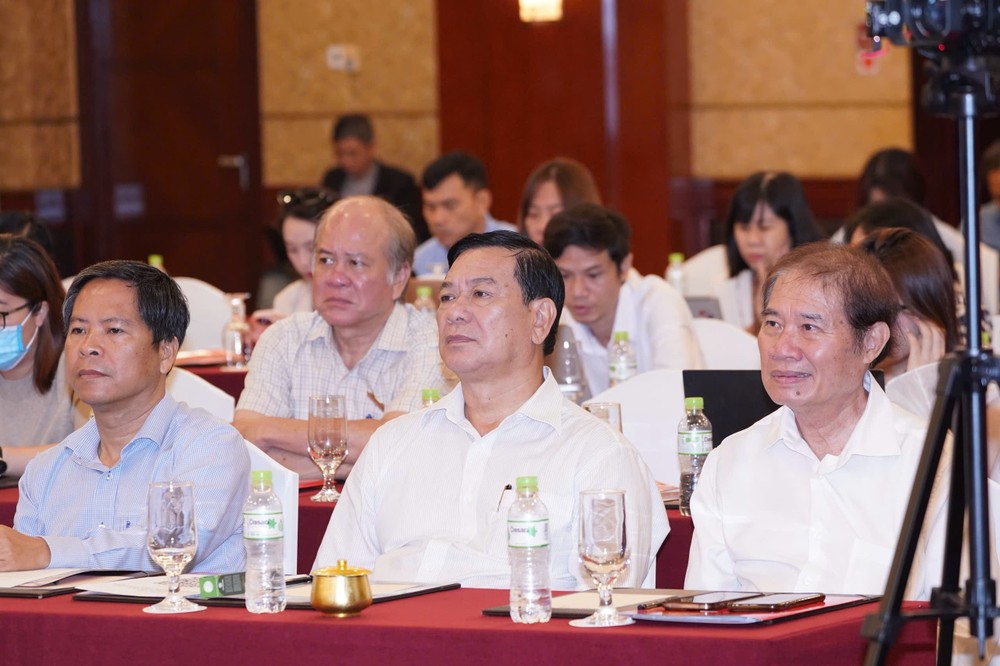
Between 2020 and 2023, the private sector contributed an average of 50.3 percent to GDP—of which private enterprises made up 24.17 percent, household businesses 23.19 percent, and cooperatives and other collective economies 2.94 percent. This outpaced contributions from State-owned enterprises (20.8 percent) and the FDI sector (20.2 percent). The private sector also represented 58 percent of total social investment, 30 percent of State budget revenue, and 30 percent of total export turnover—while creating 82 percent of all employment. The sector has led innovation, expanded its participation in global value chains, and fostered a startup ecosystem with around 4,000 startups in 2024—2.7 times more than in 2015.
Vietnam is also witnessing the emergence of major private conglomerates in key sectors that are making their mark internationally. Entrepreneurs are increasingly socially responsible, contributing an estimated $1 billion annually to social welfare. However, domestic firms remain relatively small in scale, with persistent limitations in competitiveness, human resource quality, technological capability, and integration into global supply chains. Many continue to struggle with land access, financing, technological upgrades, participation in national-level projects, digital transformation, and green transition. Internal linkages among private enterprises also remain weak.
Resolution 68-NQ/TW on private sector development affirms that private businesses should serve as a core engine of the national economy. It envisions a transparent, efficient, low-cost, and internationally aligned business environment that supports regional and global competitiveness—replacing outdated views of entrepreneurs as mere “merchants” with the modern notion of businesspeople as “warriors” of the economic battlefield.
Key breakthrough strategies under the resolution include transforming perceptions and mindsets; reigniting national pride and aspirations; improving the legal and policy framework to protect ownership rights, the right to do business, and equal competition; and enforcing contracts. It also calls for better access to land, capital, and high-quality labor.
The resolution sets concrete benchmarks, aiming for 3 million enterprises by 2045. By 2030, the private sector is projected to contribute 55–58 percent of GDP, rising to over 60 percent by 2045.

To help domestic enterprises grow stronger, Dr. Can Van Luc urged the government to place strategic orders with private firms in key national projects and to support their development based on contribution rather than scale. He also called for clearer regulations on public-private partnerships, and for improved data-sharing mechanisms and private-sector metrics.
For their part, businesses and household enterprises must shift toward long-term, sustainable strategies—integrating ESG (Environmental, Social, and Governance) principles into their operations. They must enhance competitiveness, embrace digital and green transitions, uphold legal compliance, and adopt ethical business standards.
Lack of support mechanisms leaves Vietnamese businesses struggling to keep pace with global rules
Speaking candidly about the mounting challenges facing businesses, Mr. Nguyen Ngoc Hoa, Chairman of the HUBA, emphasized that the resilience of enterprises is being steadily eroded. From 2022 to 2024, the wave of businesses exiting the market has risen sharply—and in just the first four months of 2025, the number of closures is already nearly half the total seen in 2024. This is not merely a short-term trend, but a sustained and concerning decline. While market dynamics naturally involve a process of selection, the mass and ongoing nature of these withdrawals—numbering in the hundreds of thousands—speaks to a deeper fragility in enterprise vitality and market resistance.

Most of the struggling businesses are micro, small, and medium-sized enterprises. Orders are drying up and consumer purchasing power is weakening. Though Vietnam’s export turnover in the past four months surpassed $102 billion, up over 10 percent year-on-year, a closer look reveals fragmentation: several strategic export sectors are already facing a lack of orders for July. Consumer spending remains tight, and beyond falling orders, a drop in consumer confidence and external market access is shrinking cash flow and threatening business survival.
The pressing question is: what systemic barriers and deep-rooted challenges are hindering businesses? According to Mr. Nguyen Ngoc Hoa, global trade policy is evolving at breakneck speed. From 2022 to 2023, US investigations into anti-dumping and tax evasion intensified; the EU implemented the Carbon Border Adjustment Mechanism (CBAM); and China, reducing exports to the US, redirected low-cost goods into Vietnam, flooding the domestic market.
With the CBAM now in its transitional phase through 2025, Vietnamese firms are required to disclose carbon dioxide emissions—without proper measurement systems, they risk being excluded from supply chains. Most SMEs lack the resources to meet ESG (Environmental, Social, and Governance) standards. From 2026 onward, CBAM will impose carbon taxes, raising compliance costs. Rising protectionism will put Vietnam at a competitive disadvantage unless reforms are enacted swiftly.
The result is a sharp rise in compliance costs—from testing and reporting to environmental standards. Smaller firms, lacking the capital to transition, will steadily lose their edge in pricing and delivery speed. “It’s not that businesses aren’t aware,” said Mr. Nguyen Van Hoa. “They want to adapt, but the support mechanisms simply aren’t there to help them meet the new rules of the game.”
HUBA surveys reveal that businesses are grappling with weak domestic demand, capital shortages, rising input costs, labor scarcities, lack of orders, and limited capabilities in risk management, technology, and human resources—all of which fall short of new global integration demands. Many firms remain outside the digital and green transitions, not because they don’t see the need, but because they cannot afford the shift.
According to data from the General Statistics Office and the Private Sector Development Research Board, only 37.4 percent of businesses are engaged in digital or green transformation. Meanwhile, 11 percent are indifferent, 27.2 percent unwilling, and 24.4 percent completely unaware. Without change, many companies will be eliminated domestically—long before they can compete globally. Business support is urgent. The real question is: how do we ensure “no one is left behind”? Solutions include access to credit, lower interest rates, policies to stimulate domestic consumption, tax and fee reductions/refunds, improved transport infrastructure, and streamlined administrative procedures.

Given that most enterprises are SMEs with limited capacity to raise capital, Mr. Nguyen Ngoc Hoa urged targeted financial policies for this segment. Support must be dual-faceted—easing lending conditions for financial institutions while crafting tailored support for large, medium, small, and micro-sized businesses.
As an open-ended solution, Mr. Nguyen Ngoc Hoa proposed creating a space for recovery and innovation. This includes regular public-private forums to resolve industry-specific obstacles, enhancing domestic supply chain linkages between SMEs and FDI firms, and establishing open credit scoring systems to boost unsecured lending capacity. Notably, he also called for the development of shared services and infrastructure to help reduce business costs.

Vice President of HIDS: Domestic firms must build resilience against retaliatory tariffs
According to Mr. Pham Binh An, Vice President of the HIDS, the current global order has given rise to tightly knit global supply chains, with China emerging as a strategic rival to the US. While China is striving to overtake the US by leveraging large-scale, competitive manufacturing, the US has seen a sharp decline in industrial output—industry now contributes just 12 percent of its GDP, with services making up 78 percent—and has become a consumption-driven, heavily import-dependent economy.

Since 2018, the US has launched a trade war that Mr. Pham Binh An characterized as a strategic maneuver to preserve its global dominance. Trump-era protectionist measures—such as retaliatory tariffs, technology bans, and efforts to re-shore manufacturing—have contributed to the fragmentation of global trade, replacing the once tightly integrated order of globalization with a patchwork of competing spheres.
Amid this fragmentation, US and EU strategies such as “friendshoring” and “nearshoring” have sought to move supply chains out of China, presenting opportunities for Vietnam. However, this shift has also made Vietnam a transshipment hub—leading to increased scrutiny and allegations of tariff circumvention in several trade defense cases.
Trade defense and retaliatory measures are escalating, especially among major economies like the US and China. These include both traditional tools—anti-dumping duties, countervailing duties, and safeguard measures—and newer mechanisms such as investment controls, technology embargoes, and stricter technical inspections for imports.

Adding to the pressure are new non-tariff barriers, especially environmental and labor standards. The EU’s Carbon Border Adjustment Mechanism (CBAM) is poised to impact Vietnam’s steel, cement, fertilizer, and aluminum sectors. Meanwhile, the US has begun enforcing the Uyghur Forced Labor Prevention Act (UFLPA), creating significant risks for Vietnam’s textile and footwear exports due to supply chain traceability concerns.
Despite a strong showing in early 2025—with GDP growth reaching 6.93 percent in Q1, the highest Q1 growth rate from 2020 to 2025—Vietnam’s economic outlook remains vulnerable. The country continues to run a trade surplus with the US but a growing deficit with China, which poses both economic and geopolitical risks.
Mr. Pham Binh An also highlighted a persistent imbalance between foreign-invested enterprises (FDIs) and domestic businesses. In recent years, FDIs—particularly from China and South Korea—have accounted for over 40 percent of Vietnam’s exports, with Northeast Asia collectively contributing more than 57 percent. This heavy dependence on foreign capital leaves Vietnam’s export sector lacking autonomy and heightens its exposure to trade frictions.

In light of these risks, Mr. Pham Binh An stressed that domestic enterprises—especially small and medium-sized ones—must enhance their financial resilience to withstand retaliatory tariffs and other shocks. Vietnam faces not only tariff-related pressures but also geopolitical tensions, supply chain scrutiny, foreign competition, and a significant trade imbalance with the US, which could trigger political and trade backlash. Exchange rate volatility, counterfeit goods, and intellectual property violations are further undermining market confidence.
Given these challenges, Mr. Pham Binh An urged the government to provide timely policy support to help domestic firms maintain production, safeguard jobs, and ensure social stability. He called for businesses to proactively strengthen compliance, improve traceability, and segment their export markets more strategically.
He recommended that Vietnamese companies categorize their export destinations by risk and potential: high-protection markets such as the US and EU; emerging markets like India, the Middle East, and Africa; and niche markets—small in scale but rich in added value. At the same time, firms must reassess and reposition their target markets to remain competitive in this increasingly volatile global trade landscape.
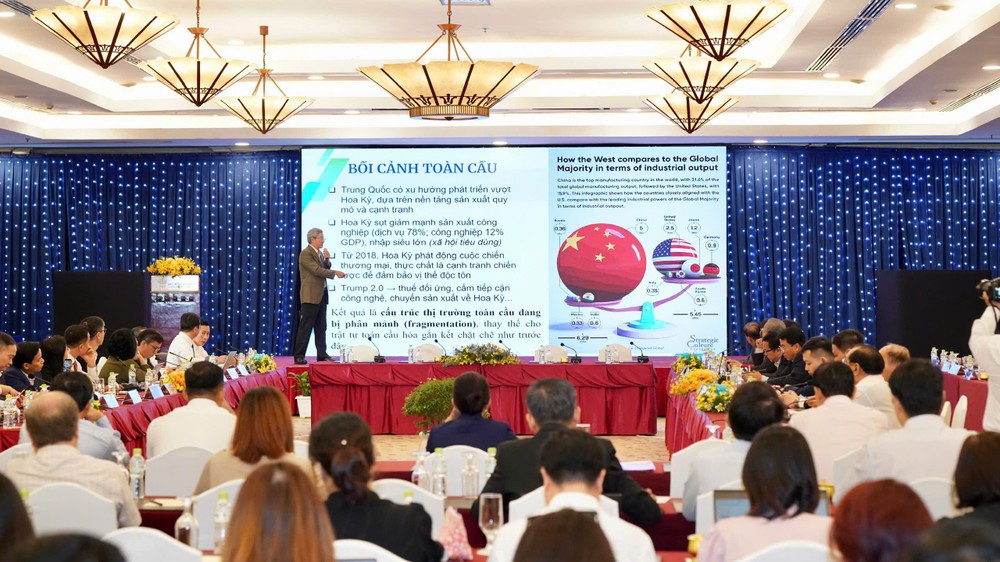



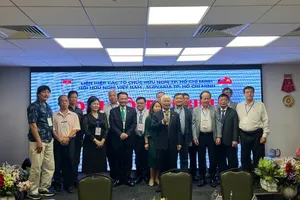

)
